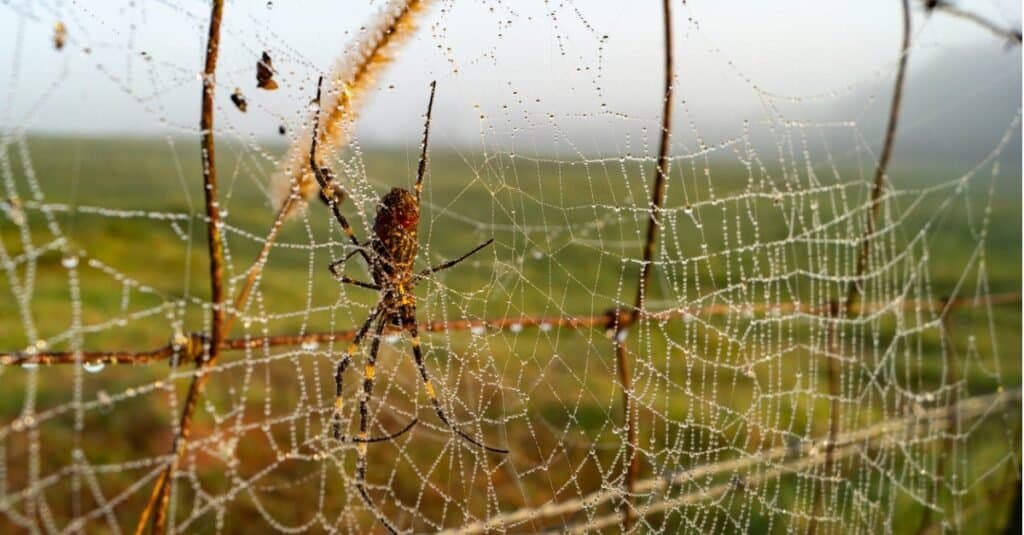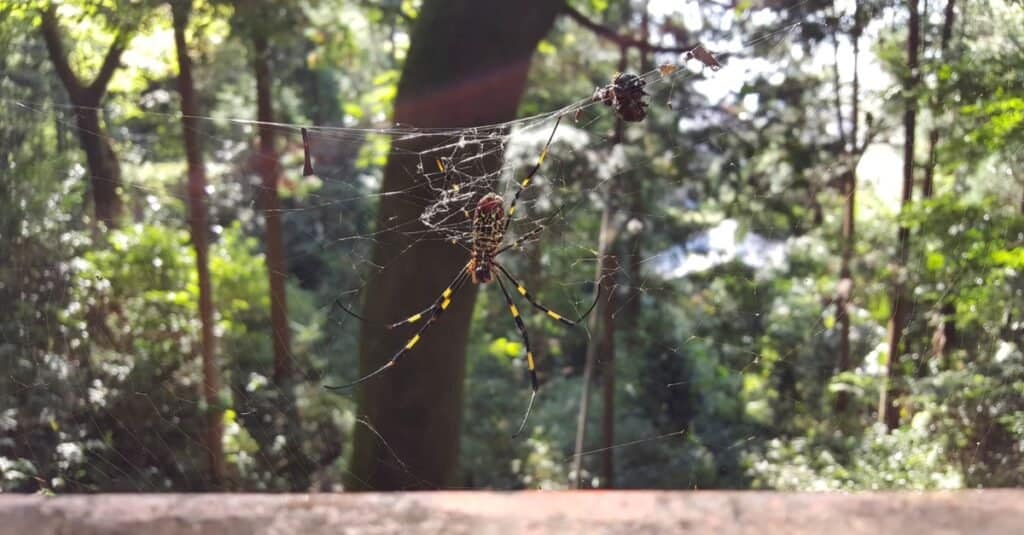When it comes to the identification of Joro spiders, let’s just say once you’ve seen one they’re hard to forget. There are a lot of remarkable facts about this spider including its size as well as the size and design of its web.
Keep reading to learn the answer to the question: How big are Joro spider webs? In addition, uncover some facts about where this insect lives, why it’s considered an invasive species, and why it’s sometimes called a golden orb weaver.
What is a Joro Spider?
Joro spiders are large arachnids measuring from three to four inches long. They have eight spindly legs. A good size comparison is this spider is about as large as the palm of an adult’s hand. Female Joro spiders feature bands of yellow and blue on the top of their body and sections of yellow and black on their legs. The underside of a female’s body is a combination of red, yellow, and black designs. Males are much smaller in size than females and are brown in color. This makes male and female identification easy in this species of spider.
The Joro spider is native to China, Japan, Korea, and Taiwan. They are also called East Asian Joro spiders. However, many of these spiders are now living in North America. Specifically, there is a big population of them in Georgia. These spiders are considered invasive species in North America. So, this brings up the question: How does the East Asian spider end up living in the state of Georgia?
How Did the Joro Spider Become an Invasive Species in Georgia?
The truth is scientists can only guess how the Joro spider ended up in Georgia. An official from the Georgia Museum of Natural History theorizes that this spider traveled from its native land to Georgia via shipping container. The stowaway spiders began to establish themselves in the habitat and reproduce. That’s how the population of this invasive species grew in the state.

©iStock.com/Lindsey Lee
Is the Joro Spider Beneficial to the Environment in Georgia?
Some invasive species take food away from native species and affect the environment in a harmful way. But, the Joro spider is having some positive effects on its habitat in Georgia.
For one thing, Joro spiders eat stink bugs – which can damage or kill crops. Joro spiders also capture mosquitoes, flies, and other pests in their orb web. So, they don’t appear to be reducing the food supply for other types of spiders that are native to Georgia.
Where Do These Spiders Spin Their Webs?
A Joro spider may build a web in bushes or between two trees that are relatively close together. In Georgia, a homeowner may see a Joro spider building a web at one corner of a porch or on a section of a swing set.
Like most spiders, Joro spiders build their web in a place where there’s a decent amount of airflow. This location makes it more likely that insects will become trapped in the web. Also, a Joro spider may build a web near a porch light or a light somewhere on a home’s property. Lots of insects are attracted to light. So, by creating a web near a light this spider increases its chances of capturing prey.
How Big Are Joro Spider Webs?
One of the most incredible facts about this spider is the size of its web. A Joro spider web can be as wide as ten feet! As a size comparison, a ten-foot web is equal in length to half an adult giraffe.
Knowing what type of web a spider creates can help you with its proper identification. This insect, sometimes known as an orb weaver, builds what is called an orb web. The web is made up of a series of orbs, or spirals. The orb or spiraling section of the web is attached to the trees or bushes around it by mooring lines to keep it from collapsing or blowing away.
In a size comparison with the web of a common house spider, the Joro spider’s web ends up the clear winner. The web of a common house spider is an inch or less in width. In fact, the bodies of most common house spiders measure just a half-inch to one inch in length. Their webs are so small, they are practically invisible unless someone is inspecting the corner of a room. But, when you think about it, the results of the size comparison between these two spider webs make a lot of sense. A large spider, like a Joro or even a baby Joro spider, is more likely to have the strength and energy necessary to build a larger web.
What is Unique About a Joro Spider Web?
Along with its intricate orb design, the threads of a Joro spider web are yellow or gold. If you study this silk web in the sunlight, it is an even brighter shade of gold. Almost sparkling!
This insect belongs to the Nephila genus of spiders sometimes referred to as golden silk orb-weavers.
Do Joro Spiders Have Their Young in Their Web?
Yes. In the fall season, a female Joro spider can lay 1000 or more eggs in an egg sac. The egg sac is light brown in color and at least one inch long in size. It is usually located at one corner or edge of the web. If the web is connected to tree branches, the female may position the egg sac beneath a gathering of leaves. Or, if the female’s web is located under the eaves of a house, she’s likely to put her egg sac in a corner of the soffit. When looking at the eave on the side of a home the soffit is located on the underside of an eave. The female wants to put her egg sac in a place where it will be protected from wind and weather conditions.
What Happens to a Baby Joro Spider?
Once the egg sac hatches in the spring, the baby Joro spiders, also called hatchlings, can live independently. They find a new place to live by ballooning to a new habitat. Ballooning is when a spider travels through the air with the help of a silk thread. The extraordinary ballooning activity of Joro spider babies is responsible for these spiders spreading to different locations in Georgia and beyond.
Their ballooning expertise allows them to travel as far as 50-100 miles in the air current before latching onto a tree – so it’s no wonder they are expanding their territory. Joro spiders have already been spotted in Tennessee, North Carolina, and South Carolina. Because they are able to survive brief freezes – it is likely that they will travel even further north.

©Seve Sivathas/Shutterstock.com
Are Joro Spiders Venomous?
Yes. But a bite from a Joro spider is not dangerous to a human unless the person has an allergy to it. The level of pain of a Joro spider bite is about equal to a bee sting. This is probably because it is larger in size than most spiders. The bite area is likely to become irritated, red and may develop a few blisters.
What Should Be Done to Treat a Joro Spider Bite?
If the bite area becomes infected or a rash forms, it’s best to get it looked at by a medical doctor. Otherwise, wash the bite area with soap and water, then dry it thoroughly. If there’s soreness or pain, gently place an ice bag onto the area.
Are Joro Spiders Aggressive?
A Joro spider’s large size may make it seem a little more threatening than other types of spiders. This would be especially true for a Georgia homeowner who sees it building a web nearby. But these spiders are not aggressive. If a person were to be bitten by this spider, it would likely happen only if the spider felt at risk of injury. For example, if a person accidentally walked into the web of the spider the spider may feel trapped and bite as a way to protect itself.
The best way to learn about and study these spiders is to observe them without touching their web. Like most other animals, they want to go about their daily activities undisturbed.
The photo featured at the top of this post is © bozmp/Shutterstock.com
Thank you for reading! Have some feedback for us? Contact the AZ Animals editorial team.






